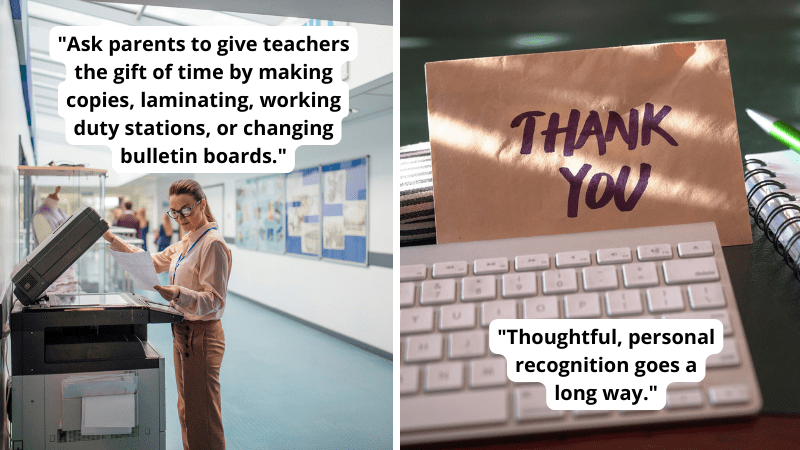On my first day as a principal, I sat down with my secretary and asked, “How much money can I spend on teachers?” I was shocked into silence when she told me I could buy one lunch per semester … and that was it. As I reflected on that, I thought to myself, Teacher appreciation is way more than a candy bar or jeans day.
As a building principal, I hired teachers because they were the experts in their content. But teacher appreciation can’t stop after hiring! I found that true appreciation was not some kind of checklist, but an ongoing and evolving process of thinking of ways to empower my teachers with what they needed and wanted.
The efforts I put into teacher appreciation paid off for the teachers, students, and our community. Hillwood Middle School, where I was principal, was named a “Texas and National School to Watch” three times, a School Transforming Learning by N2 Learning, and a Best Middle School by U.S. News & World Report. We also received the first Texas Whole Child Award from Texas ASCD. When you have happy, supported teachers, they will push themselves and their students to new levels, try new things, and step up to help when needed.
Making teachers feel valued isn’t a checklist. A school mug in May during Teacher Appreciation Week—as we say where I’m from—ain’t gonna cut it. True teacher appreciation is an ongoing and evolving process. Here’s how real teacher appreciation has transformed my schools, as well as a few ideas you can easily incorporate to help teachers feel valued and appreciated.
5 Ways Principals Can Show Genuine Appreciation for Teachers
1. Engage them with the local community during PD
Prior to an in-service day, contact local businesses, restaurants, and apartments to partner with you by providing coupons, free trinkets, and/or answers to specific questions for teachers. Make fun QR codes and send the teachers into your community on a scavenger hunt. Teachers will have fun, get to engage with the local community, and definitely won’t be reading a PowerPoint from a cafeteria table.
2. Make standardized testing less of a slog
We all have the “pleasure” of state testing, and we all need to actively monitor while the students are testing. Partner with a community member such as an insurance company and have them donate pedometers with their business logo on them. Then on state testing days, give teachers the option to check out a pedometer to track their steps. I like to offer community-donated prizes for the teachers with the most steps. This is a fun and competitive way to actively monitor during state testing.
3. Ask families for help in a variety of ways
Parents want to help, but often they just don’t know how or assume they can’t help in the way you need. If you want to stock up the teachers’ lounge, request specific items like coffee and tea pods so parents don’t have to guess. Another great thing to ask for is gift certificates. When you include specific places and dollar amounts, the response might surprise you.
Help from parents in supporting teachers doesn’t always have to be in the form of something that costs money. You can ask parents to sign up to make copies, cut out instructional items, laminate, and so on. A huge teacher favorite is to ask for parent volunteers to work teacher duty stations periodically before and after school to give the teachers 30 minutes of time. Teachers always need more time, even if a half hour doesn’t seem like much.
4. Reach out with handwritten notes
When’s the last time someone gave you a handwritten note? Use card stock to print postcards or get a bulk set of note cards and envelopes. Then take the time to write a quick, simple note. Three sentences max. If you take a couple of minutes each day for one teacher, you’ll have recognized your whole staff within the first few months.
You can do a spin on this at your next staff meeting. Pass out postcards and challenge teachers to recognize a teacher or staff member they haven’t talked to in the past few weeks by sending them a note. At the meeting after that, reward anyone who sent a note, and give everyone a chance at round two. Thoughtful, personal recognition goes a long way.
5. Give teachers the most important gift: time
Split your teachers into groups. Have each group create a T-chart with instructional initiatives such as lesson planning, project-based learning, and essential questions on one side, and on the other side have them list school climate initiatives such as houses, student clubs, and hour lunches. While they’re doing this, have them put a D by any district initiatives, since these are initiatives we’re all required to do. Next ask them, “Look at the rest of your tasks. What can we take off of your plates and how?” Have them answer the question on the bottom of their chart. Take their suggestions to your school leadership team and work your way through the list while making sure you continually communicate with your teachers about the process and what is happening.
It seems like every year teachers are viewed less and less as the amazing, generous, and knowledgeable people they are. Now more than ever, it is vital for school leaders, parents, and teachers to take the time to ensure their teachers truly feel appreciated and needed.
If you would like more ideas on how to empower, value, and appreciate teachers, check out Kathleen’s book School Transformation Through Teacher Appreciation, available on Amazon, and subscribe to her newsletter at www.KathleenEckert.com.


